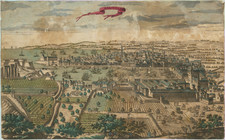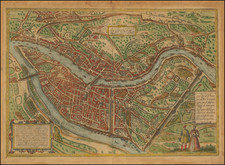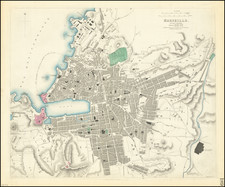This finely executed 1839 map, titled La Ville du Mans et Ses Environs, created by Captain J.R. Lombard, meticulously depicts the city of Le Mans and its surroundings during the mid-19th century. This cartographic work integrates comprehensive geographic and architectural details, providing a multifaceted view of the urban and rural landscapes. The map is notable for its intricate renderings of prominent buildings and landmarks, alongside explanatory notes and a key to symbols used.
Prepared by Captain Lombard between January 1 and April 1, 1839, the central map illustrates Le Mans, focusing on the city's layout, streets, and significant structures. Surrounding the main map are detailed vignettes of key architectural edifices, including the Cathedral of Saint Julian and various public buildings, offering a glimpse into the city's architectural heritage. The Cathedral of Saint Julian, with its roots in the 11th century, is prominently featured, reflecting its historical and cultural importance to the city.
Historical context enriches the map, with sections dedicated to ancient Roman sites, medieval structures, and modern developments of the time. The inclusion of Roman antiquities and the ancient city's layout underscores Le Mans' long-standing historical significance. The map's explanatory text provides insights into the topographical features, cadastral changes, and archaeological findings, bridging the past with the present urban configuration.
The cartographic technique employed includes precise contour lines, delineating the terrain's relief, and a comprehensive legend elucidating various land uses, boundaries, and constructions. This methodological approach exemplifies mid-19th century cartographic standards and the emerging scientific rigor in urban mapping.
The maker, Jean-Baptiste Lombard, was, at the time, aide-de-camp to General Rogé, commanding the department of Sarthe.
Le Mans
The early 19th century saw Le Mans solidifying its cultural and architectural identity. The construction and restoration of significant buildings were prominent during this period. The Cathedral of Saint Julian, a focal point of the city’s religious life, witnessed various restorations aimed at preserving its historical and architectural integrity. Additionally, the construction of the theater, which commenced in 1838, signified the city’s commitment to cultural enrichment and public entertainment.
Le Mans also experienced industrial growth, particularly with the advent of the Industrial Revolution. The city’s proximity to the Sarthe River facilitated the establishment of mills and factories, which spurred economic activity and urban expansion. The development of transportation infrastructure, including roads and the introduction of the railway in the mid-19th century, further enhanced Le Mans' connectivity and economic prospects.
The urban landscape of Le Mans in the first half of the 19th century was marked by notable public works and improvements. The Asylum of Sarthe, inaugurated in 1828, reflected the era's social reforms and the growing emphasis on public health and welfare. This period also saw the enhancement of public spaces, roads, and other municipal facilities, contributing to the overall modernization of the city.
Throughout these decades, Le Mans retained its historical significance while embracing modernization. The city's historical sites, including Roman remains and medieval fortifications, remained integral to its identity. This blend of ancient heritage and contemporary progress created a unique urban environment that attracted both residents and visitors.
Le Mans also played a role in the broader political and social movements of the time. The city was a witness to the tumultuous events of the July Revolution in 1830, which led to the establishment of the July Monarchy under Louis-Philippe. These national events influenced local governance and the political atmosphere in Le Mans, contributing to the city's evolving identity.











![[ Arras ] Atrebatum, fertilissimae Artesiae Urbs primaria, elegantissimo situ . . .](https://storage.googleapis.com/raremaps/img/small/74979.jpg)

![[ Marseille ] La Citta di Marsiglia Celebre Porto di Mare del Governo della Provenza in Francia](https://storage.googleapis.com/raremaps/img/small/97837.jpg)
![[Chalon-sur-Saone] Le Vray Pourtraict de la Ville de Chalon](https://storage.googleapis.com/raremaps/img/small/74199.jpg)